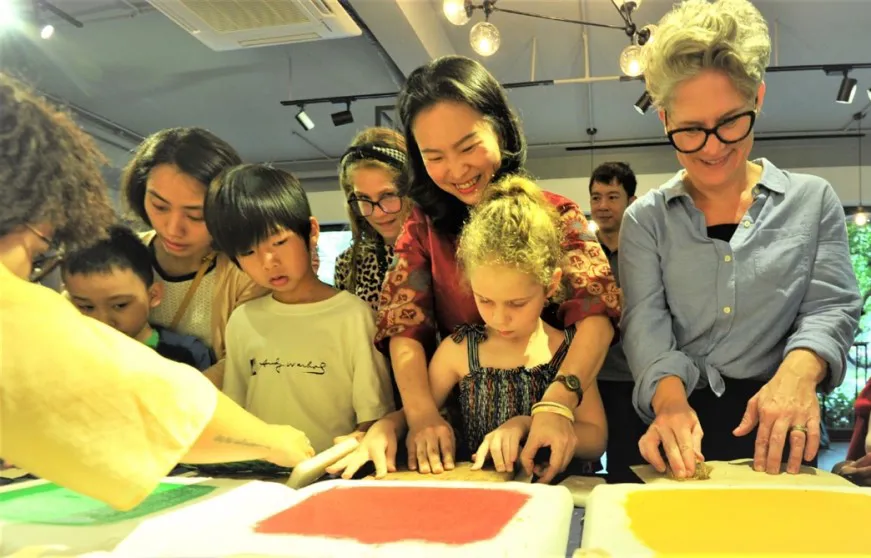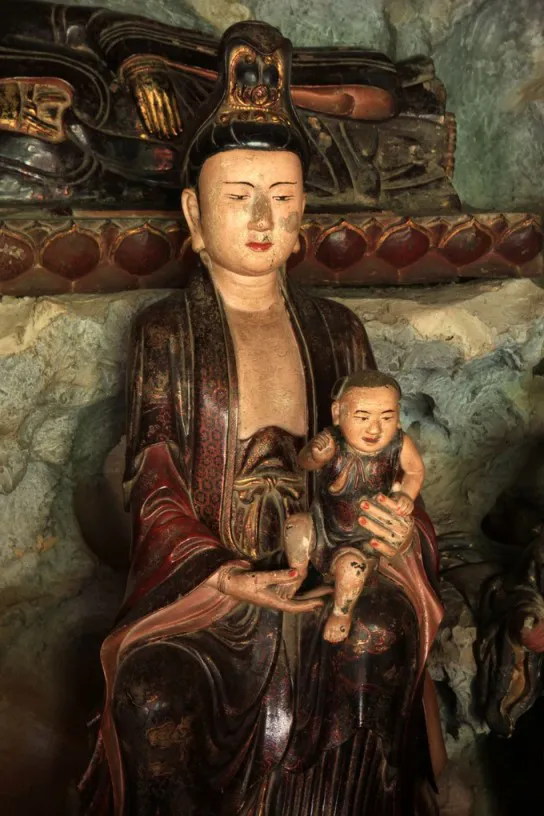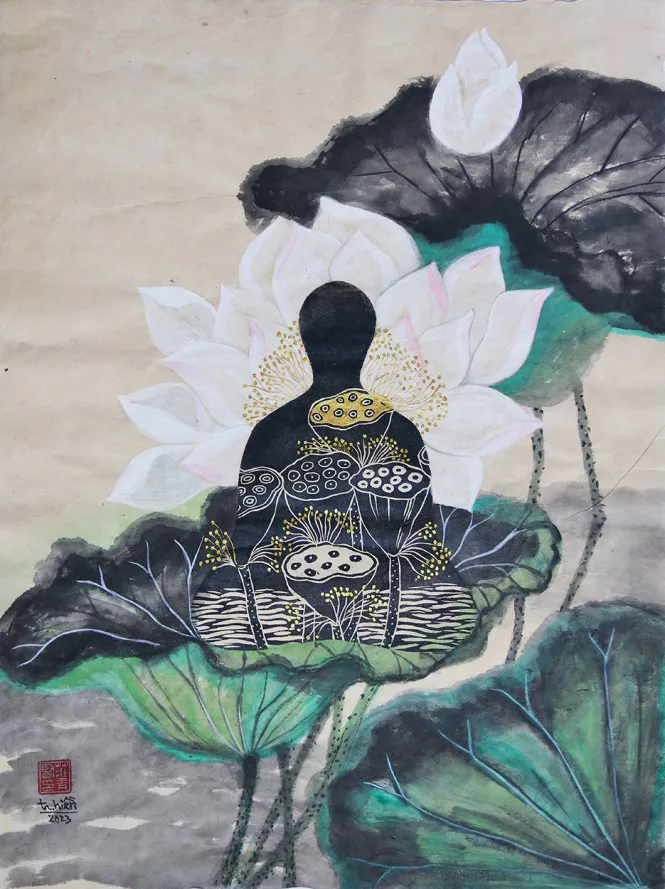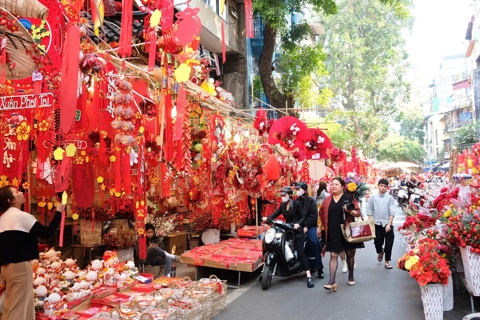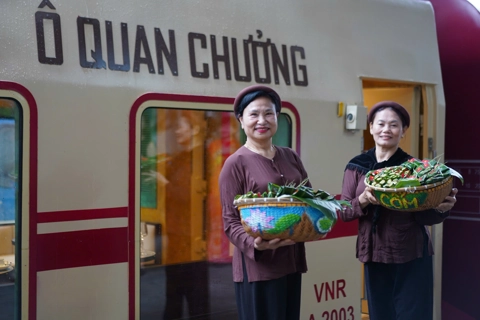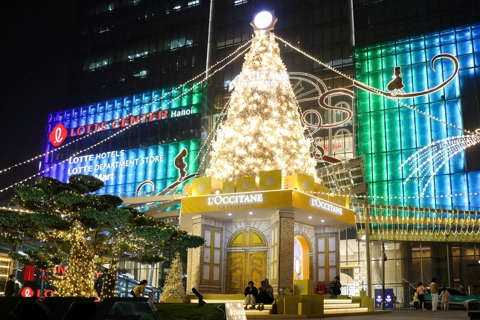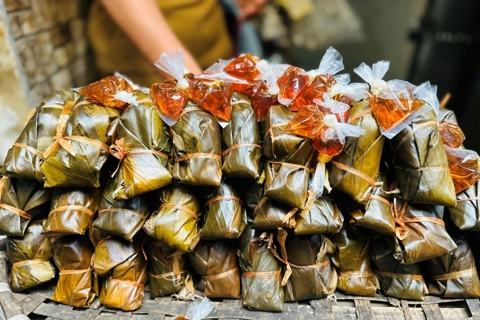An explorer of ancient fine arts
Her paintings feature repeating motifs such as Buddha silhouettes, flowers, and energy symbols in a variety of layouts.
It's a well-known fact that many Vietnamese people go to Buddhist temples without knowing which Buddha and what the statue they're praying to represents.
That's one of the reasons why Hanoian painter Trang Thanh Hien pursued the research about traditional culture and religion of Vietnam.
Since 1998, along with teaching at the Vietnam University of Fine Arts, Hien has embarked on a passionate journey researching ancient fine arts.
| Researcher Trang Thanh Hien teaches foreigners how to print traditional Vietnamese paintings. Photo courtesy of the artist |
"I feel that it is a world right next to me, omnipresent in life, in society out there, but too few people understand it. That's why I want to explore the knowledge of traditional fine arts and share it with people," Hien said.
With this in mind, Hien conducted fieldwork in almost every temple and pagoda in the north, from Hanoi to Bac Ninh, Hung Yen, and Ninh Binh.
Trang Thanh Hien's first book was published in 2005, titled The Image of Guan Yin of Thousand Arms and Eyes in Vietnam. The book was highly appreciated at that time for its summary and evaluation of the development of the art of Guan Yin statue making and received an award from the Vietnam Publishers Association.
What distinguishes Trang Thanh Hien from other researchers in history, cultural heritage and archaeology is her research on the visual value of ancient fine arts.
Vietnam's ancient fine arts are extensively associated with communal houses, pagodas, temples, and folk culture. Still, the artistic values and the connection between life, society, and fine arts have remained enigmatic to many.
As a result, Hien continued to delve into the subject, and it was not until she published her second book, The Art of Creating Buddha Statues in Vietnamese Temples, in 2020 that she felt accomplished.
According to Hien, many Vietnamese academics write books for researchers, not for the general public, so she sought to describe the art in the simplest way possible, even for those not knowledgeable about archaeology or art.
In addition to her research, Hien continues to paint and teach, using the combination of experience and knowledge she has gained from many years of fieldwork.
Her paintings feature repeating motifs such as Buddha silhouettes, flowers, and energy symbols in a variety of layouts. Each represents a restless mood, unsure of one's happiness or sadness, not knowing where to go in this spiritual realm full of unanswered questions.
| The statue of Guan Yin at Mia Pagoda. Photo courtesy of Trang Thanh Hien |
Hien said she's particularly impressed by the statues at Mia Pagoda, Duong Lam Commune, Son Tay District, Hanoi.
"The ancient Guan Yin statue, dating back to the 17th century, is a work of visual art that evokes emotions in me every time I look at it. It is the embodiment of Vietnamese mothers who are resigned and resilient. The engraved lines are soft, intricate, delicate and kind," Hien said.
According to Hien, in the past, people often made statues out of wood and clay. It's not because Vietnamese people can't afford bronze or gold statues. They chose wood because it is familiar and friendly. In addition, wooden statues are easy to carve, which allows for more creativity.
Hien realized that nowadays, people tend to build large pagodas and cast enormous Buddha statues. People often lack the knowledge to restore ancient sculptures when they are damaged.
"Vietnamese people need a sense of protection, familiarity, and friendliness when they visit pagodas, so the statues of the past were very modest," Hien explained.
| Trang Thanh Hien's painting to be exhibited. |
She will open her solo exhibition "Projectivity" at the Vietnam University of Fine Arts on November 7-15, presenting 44 paintings on do (poohnah) paper and sculptures steeped in Buddhist philosophy.
"I compare my soul to the surface of a lake, which reflects a myriad of life events. My work is the refraction of life's values. They embody not only color images, not only pen and ink or image-making techniques, but also my research into ancient art, Buddhist art, and my soul," Hien said.
Associate Professor, painter Nguyen Nghia Phuong, Vice Rector of Vietnam University of Fine Arts, said Trang Thanh Hien is not only passionate about theory, but also practices art with burning energy.
"In this solo exhibition, she presents a comprehensive, multifaceted art that blends the languages of painting, graphics, and sculpture with the fusion of familiar traditional symbols in the personal artworks," Phuong said.
He believes the works all present femininity in an unpredictable spirit, oscillating between the elegant and the mundane, between intense movement and freedom and serenity.

